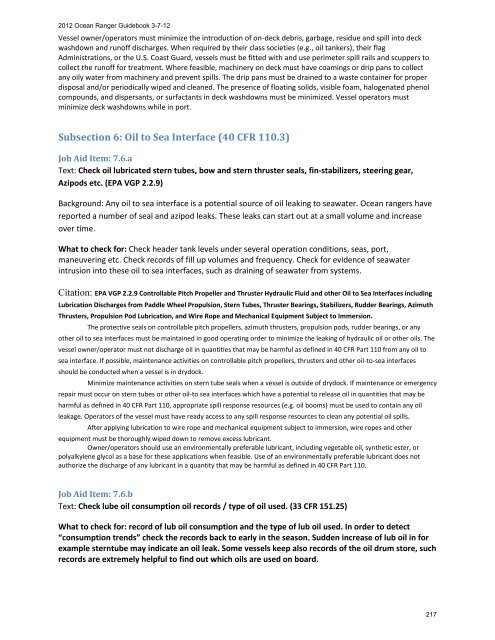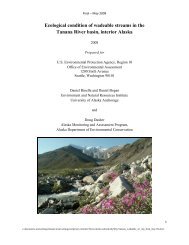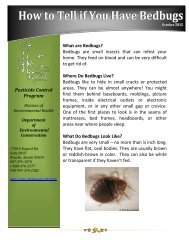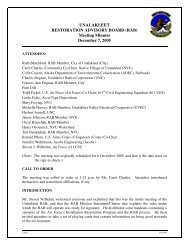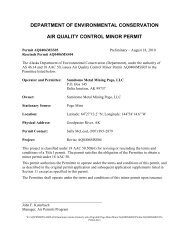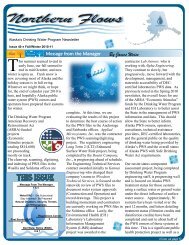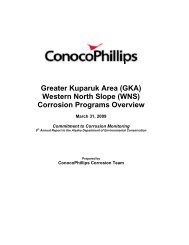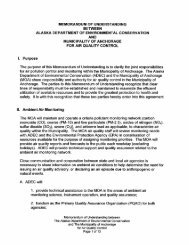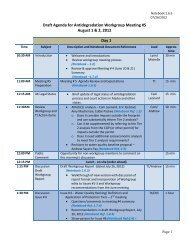2012 Ocean Ranger Guidebook Revision 3-7-12 - Alaska ...
2012 Ocean Ranger Guidebook Revision 3-7-12 - Alaska ...
2012 Ocean Ranger Guidebook Revision 3-7-12 - Alaska ...
You also want an ePaper? Increase the reach of your titles
YUMPU automatically turns print PDFs into web optimized ePapers that Google loves.
<strong>20<strong>12</strong></strong> <strong>Ocean</strong> <strong>Ranger</strong> <strong>Guidebook</strong> 3-7-<strong>12</strong><br />
Vessel owner/operators must minimize the introduction of on-deck debris, garbage, residue and spill into deck<br />
washdown and runoff discharges. When required by their class societies (e.g., oil tankers), their flag<br />
Administrations, or the U.S. Coast Guard, vessels must be fitted with and use perimeter spill rails and scuppers to<br />
collect the runoff for treatment. Where feasible, machinery on deck must have coamings or drip pans to collect<br />
any oily water from machinery and prevent spills. The drip pans must be drained to a waste container for proper<br />
disposal and/or periodically wiped and cleaned. The presence of floating solids, visible foam, halogenated phenol<br />
compounds, and dispersants, or surfactants in deck washdowns must be minimized. Vessel operators must<br />
minimize deck washdowns while in port.<br />
Subsection 6: Oil to Sea Interface (40 CFR 110.3)<br />
Job Aid Item: 7.6.a<br />
Text: Check oil lubricated stern tubes, bow and stern thruster seals, fin-stabilizers, steering gear,<br />
Azipods etc. (EPA VGP 2.2.9)<br />
Background: Any oil to sea interface is a potential source of oil leaking to seawater. <strong>Ocean</strong> rangers have<br />
reported a number of seal and azipod leaks. These leaks can start out at a small volume and increase<br />
over time.<br />
What to check for: Check header tank levels under several operation conditions, seas, port,<br />
maneuvering etc. Check records of fill up volumes and frequency. Check for evidence of seawater<br />
intrusion into these oil to sea interfaces, such as draining of seawater from systems.<br />
Citation: EPA VGP 2.2.9 Controllable Pitch Propeller and Thruster Hydraulic Fluid and other Oil to Sea Interfaces including<br />
Lubrication Discharges from Paddle Wheel Propulsion, Stern Tubes, Thruster Bearings, Stabilizers, Rudder Bearings, Azimuth<br />
Thrusters, Propulsion Pod Lubrication, and Wire Rope and Mechanical Equipment Subject to Immersion.<br />
The protective seals on controllable pitch propellers, azimuth thrusters, propulsion pods, rudder bearings, or any<br />
other oil to sea interfaces must be maintained in good operating order to minimize the leaking of hydraulic oil or other oils. The<br />
vessel owner/operator must not discharge oil in quantities that may be harmful as defined in 40 CFR Part 110 from any oil to<br />
sea interface. If possible, maintenance activities on controllable pitch propellers, thrusters and other oil-to-sea interfaces<br />
should be conducted when a vessel is in drydock.<br />
Minimize maintenance activities on stern tube seals when a vessel is outside of drydock. If maintenance or emergency<br />
repair must occur on stern tubes or other oil-to sea interfaces which have a potential to release oil in quantities that may be<br />
harmful as defined in 40 CFR Part 110, appropriate spill response resources (e.g. oil booms) must be used to contain any oil<br />
leakage. Operators of the vessel must have ready access to any spill response resources to clean any potential oil spills.<br />
After applying lubrication to wire rope and mechanical equipment subject to immersion, wire ropes and other<br />
equipment must be thoroughly wiped down to remove excess lubricant.<br />
Owner/operators should use an environmentally preferable lubricant, including vegetable oil, synthetic ester, or<br />
polyalkylene glycol as a base for these applications when feasible. Use of an environmentally preferable lubricant does not<br />
authorize the discharge of any lubricant in a quantity that may be harmful as defined in 40 CFR Part 110.<br />
Job Aid Item: 7.6.b<br />
Text: Check lube oil consumption oil records / type of oil used. (33 CFR 151.25)<br />
What to check for: record of lub oil consumption and the type of lub oil used. In order to detect<br />
“consumption trends” check the records back to early in the season. Sudden increase of lub oil in for<br />
example sterntube may indicate an oil leak. Some vessels keep also records of the oil drum store, such<br />
records are extremely helpful to find out which oils are used on board.<br />
217


